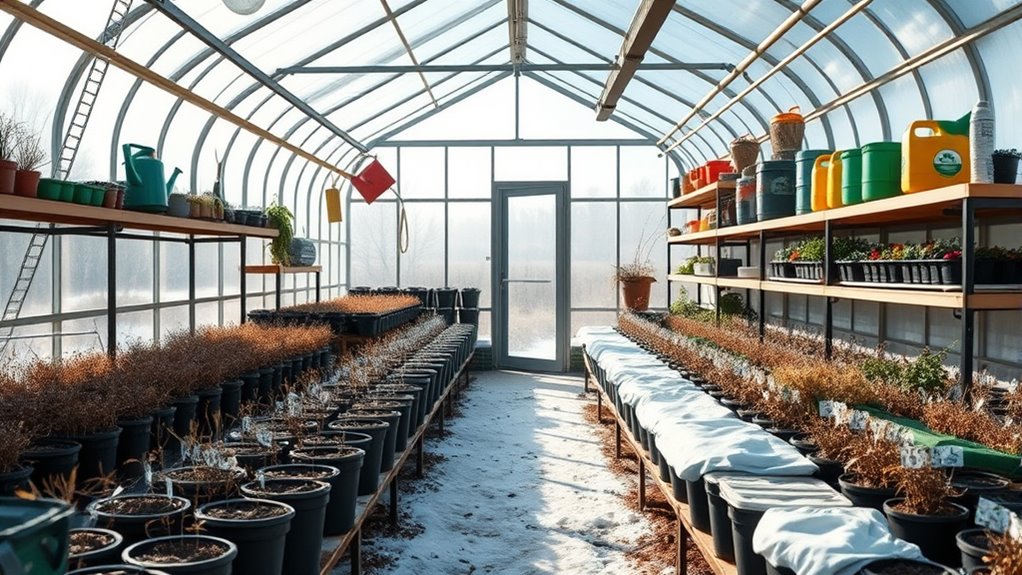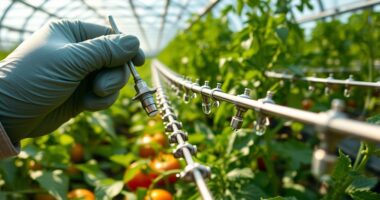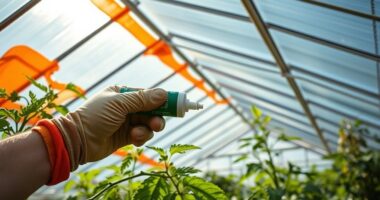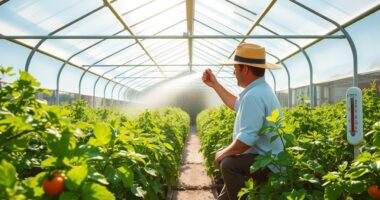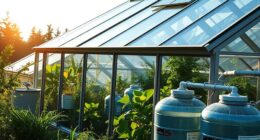During the off-season, make certain your greenhouse is well-maintained by insulating gaps, inspecting vents, and cleaning surfaces to prevent pests. Remove plant debris and store seeds or overwintering plants in cool, dry spots to reduce pest habitats. Consider installing backup power and sealing cracks to protect against cold weather. Keeping your greenhouse dry, well-ventilated, and pest-free sets you up for a healthier start next season. If you want tips on mastering winter prep, continue exploring.
Key Takeaways
- Winterize and insulate the greenhouse to maintain heat and prevent cold damage during the off-season.
- Remove or store plants and materials to reduce pest habitats and minimize maintenance needs.
- Conduct pest prevention measures by cleaning surfaces, sealing gaps, and using natural deterrents.
- Ensure ventilation, humidity control, and proper airflow to prevent mold and fungal issues.
- Prepare backup power and structural protections to safeguard the greenhouse during storms and harsh weather.
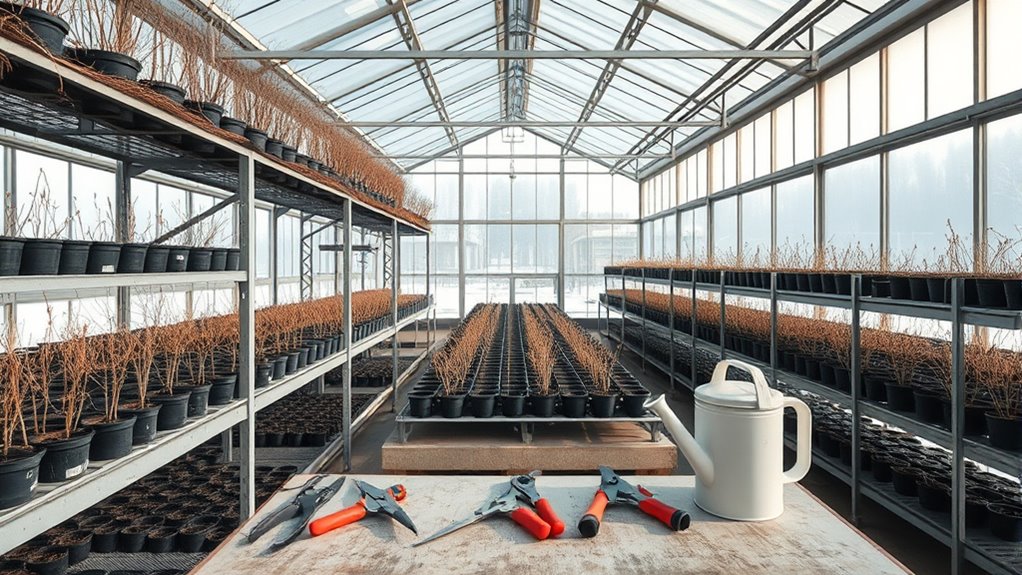
Ever wondered how to keep your greenhouse in top shape during the off-season? The key is to implement effective winterization tips and pest prevention strategies that protect your structure and guarantee you’re ready for the next growing cycle. First, focus on winterizing your greenhouse to prevent damage from cold temperatures and harsh weather. Check your ventilation systems, seals, and insulation, making sure everything’s airtight and capable of retaining heat. Insulate any gaps around doors and vents to minimize heat loss, and consider installing thermal curtains or bubble wrap on the interior to boost insulation. If your greenhouse has heating systems, test them out now to confirm they’re functioning properly, and make any necessary repairs or upgrades. Drain and store any equipment that isn’t needed during the off-season, such as irrigation lines or fans, to prevent freezing and damage. Additionally, reliable backup power can be a valuable safety measure in case of power outages during winter storms, ensuring your greenhouse remains protected and functional. While winterizing is essential, don’t forget pest prevention strategies. During the off-season, pests often seek shelter in undisturbed, warm spaces. To prevent infestations, remove any plant debris, fallen leaves, or old plant material that could harbor pests or diseases. Clean and disinfect the growing surfaces, benches, and tools to eliminate eggs, larvae, or spores that may be hiding. Seal any cracks or openings where pests could enter, especially around vents, doors, and windows. Consider applying a pest barrier or natural deterrent, like diatomaceous earth or neem oil, around the greenhouse perimeter. Monitoring is critical even when you’re not actively growing, so set up sticky traps or pheromone monitors to catch pests early, giving you a head start on control measures when the growing season resumes. Additionally, managing humidity and airflow during the off-season helps prevent mold and fungal issues. Ensure that the vents and exhaust fans are working correctly, and keep the interior dry by avoiding excess moisture buildup. Properly ventilating your greenhouse during the winter months prevents condensation, which can lead to mold growth and plant diseases once growth resumes. If you plan to leave plants or seeds inside, choose hardy varieties or store them in cool, dry conditions away from pests. Otherwise, removing or overwintering plants elsewhere helps reduce pest habitats and keeps your greenhouse cleaner.
Frequently Asked Questions
How Often Should I Check My Greenhouse During Off-Season?
You should check your greenhouse at least once a week during the off-season. During these visits, perform seasonal pruning to keep plants healthy and prevent disease. Also, inspect and maintain equipment like heaters, fans, and ventilation systems to make sure everything functions properly when you restart active growing. Regular checks help you catch issues early, saving time and effort when the growing season begins again.
Can I Use the Same Fertilizers in Winter?
Think of your greenhouse as a dormant garden waiting for spring’s symphony. You can’t use the same fertilizers in winter because plants need different nutrients during their rest. Store your fertilizers properly, away from moisture, to preserve their potency. During winter, focus on minimal feeding, emphasizing nutrients that support root health and maintenance. Adjust your fertilizing routine to match winter nutrient needs, ensuring your plants stay healthy and ready to flourish when growth resumes.
What Pests Are Common During the Off-Season?
During the off-season, you might encounter pests like aphids, spider mites, and fungus gnats. To manage them, focus on pest identification to determine the specific issue. Implement seasonal pest control methods such as introducing beneficial insects or applying organic insecticides. Regularly inspect your greenhouse to catch infestations early. Staying vigilant helps keep pests under control, ensuring your plants stay healthy when growth resumes.
How Do I Prevent Mold and Mildew?
Think of your greenhouse as a breathing organism—you must keep it dry to prevent mold and mildew from taking hold. To achieve mold prevention and mildew control, guarantee good air circulation by opening vents and using fans. Keep humidity low, clean surfaces regularly, and remove any dead plant material. These steps help maintain a dry environment, making it less inviting for mold and mildew to grow, keeping your greenhouse healthy year-round.
Is It Necessary to Heat My Greenhouse in Winter?
You should heat your greenhouse in winter if temperatures drop too low for your plants to survive. Incorporate winter insulation to retain heat efficiently, reducing energy costs. A reliable heating system ensures consistent warmth, preventing frost damage and keeping plants healthy. Without proper heating, your greenhouse could experience temperature fluctuations that harm your plants. So, assess your climate and plant needs to decide if winter heating is essential for your greenhouse.
Conclusion
So, as you prepare your greenhouse for the off-season, remember that even in quiet times, your plants benefit from a little extra attention. It’s funny how, just when you think you’ve done enough, you discover a hidden corner that needs a quick tidy-up or a forgotten tool tucked away. These small tasks keep your greenhouse ready for when the season turns again, making the upcoming growth cycle feel that much more rewarding—and maybe even a little surprising!
